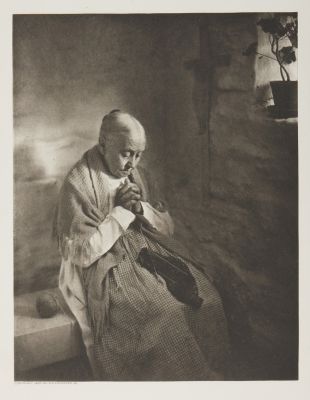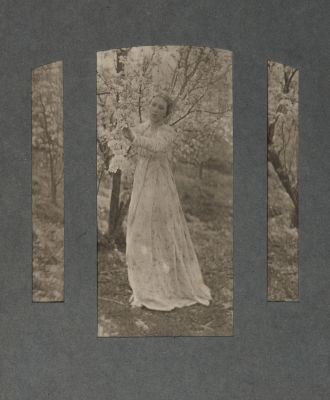
Title
Ebony and IvoryArtist
Day, Holland (American, 1864-1933)Publication
American Pictorial Photography, Series OneDate
1899Process
PhotogravureAtelier
Photochrome Engraving Co.Image Size
16.6 x 14 cmSheet Size
38 x 28 cm
“He has aimed throughout his work to suggest, not the mere beauty that delights the eye, but the grace which moves the intellectual and higher sensibilities “ William Murray, Camera Notes, 1898
In the late nineteenth century, painters and photographers pursued the representation of an idealized beauty, inspired by Italian Renaissance artists such as Michelangelo and Leonardo da Vinci. Themes of allegory and myth were widely explored in the arts at this time, particularly in Britain in the writings of Walter Pater and Oscar Wilde. At the turn of the century painting and photography were part of a wider artistic search for harmony between subject matter and expression. Artists found inspiration in each other’s practice and continued to share ideas through illustrated books and journals. This spirit of collaboration and interchange led photographer Fred Holland Day to claim that ‘the photographer no longer speaks the language of chemistry, but that of poetry.’ (Painting with Light, Tate, London 2016).
Day began photographing people of color in Boston in the mid-nineties, a period marked by increasing racial tension and polarization… His own mythological conception of the black race leads us to explore Day’s orientalism, and how popular stereotypes of Africa were informing his imagery. In Ebony & Ivory (1897), his most important photograph depicting race, Day’s black-skinned model sits in profile, his head cocked slightly away from the viewer. As he perches gracefully upon a leopard skin, his defined musculature and the luster of his body contrast with the bright white marble replica of a dancing satyr the man holds in his right hand. The photograph signals the nexus of the Christian and Greek worlds with the world of ancient Africa. By juxtaposing the seminude body with a classical symbol, Day established the dualities of nature and culture, and black and white. Ebony & Ivory underscores his sophisticated process of conceptualization, and his conscious appropriations from the history of art. Ebony & Ivory is an exercise in technical mastery for artistic effect. In the context of pictorial photography at the century’s end, this powerful, yet highly problematic, image seems deliberately ambiguous. (Suffering the Ideal p. 23)
As head of the Camera Notes publication committee, Alfred Stieglitz issued a limited edition of 150 portfolios in the fall of 1899 to exemplify the most characteristic examples of pictorial photography in America. The complete series would be the most “representative collection of pictures ever published, and should be in the hand of every serious student of pictorial photography, not alone as a record of representative American work, but because of the exceptional opportunity afforded by it of perfecting one’s own work through the careful, conscientious study of that or others.” The portfolio, American Pictorial Photography, featured eighteen photogravures printed on Indian paper. Arranged, engraved, and printed by the Photochrome Engraving Company, the photogravures were “so remarkably executed as to deceive the eye into the belief that they are original platinum and carbon prints and not merely reproductions therefrom. The engravers have every reason to feel proud of their work, which has attracted great attention wherever shown, and which deserves to be ranked with, if not as, the best work of the kind ever done in this country.” Greenough p. 938
Reproduced / Exhibited
Bulletin of the Metropolitan Museum of Art, New York. New York, NY, 1978
References
Day, Fred H, and James Crump. Suffering the Ideal. Santa Fe: Twin Palms Publishers, 1995.
Greenough, Sarah, and Alfred Stieglitz. Alfred Stieglitz: The Key Set : the Alfred Stieglitz Collection of Photographs. Washington, D.C: National Gallery of Art; New York: Harry N. Abrams, 2002.



